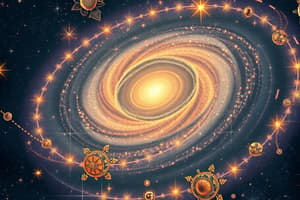Podcast
Questions and Answers
What classification scheme was developed by Hubble?
What classification scheme was developed by Hubble?
- Five types of galaxies
- Three types of galaxies
- Four types of galaxies (correct)
- Two types of galaxies
What are the 3 major types of galaxies?
What are the 3 major types of galaxies?
Spiral Galaxies, Elliptical Galaxies, Irregular Galaxies
Describe Spiral Galaxies.
Describe Spiral Galaxies.
They look like flat white disks with yellowish bulges at their centers, filled with gas and dust.
How do Irregular Galaxies appear?
How do Irregular Galaxies appear?
What characterizes Elliptical Galaxies?
What characterizes Elliptical Galaxies?
What does the disk component of a galaxy consist of?
What does the disk component of a galaxy consist of?
What is the Halo component?
What is the Halo component?
Other spiral galaxies—known as ______ spirals, appear to have a straight bar of stars.
Other spiral galaxies—known as ______ spirals, appear to have a straight bar of stars.
How do elliptical galaxies differ from spiral galaxies?
How do elliptical galaxies differ from spiral galaxies?
Elliptical galaxies differ from spiral galaxies in that they do not have significant _____.
Elliptical galaxies differ from spiral galaxies in that they do not have significant _____.
How are galaxies grouped?
How are galaxies grouped?
What is a Standard Candle in astronomy?
What is a Standard Candle in astronomy?
Flashcards
Hubble's galaxy classification
Hubble's galaxy classification
A system that sorts galaxies into types based on their shape, like elliptical, spiral, and irregular.
Spiral Galaxy
Spiral Galaxy
Flat, disk-shaped galaxy with a yellowish central bulge and prominent spiral arms containing cool gas, dust, and ionized gas.
Elliptical Galaxy
Elliptical Galaxy
Round or oval-shaped galaxy with little cool gas and dust, often red or yellow in color, and mostly contains older stars.
Irregular Galaxy
Irregular Galaxy
Signup and view all the flashcards
Disk Component (Galaxy)
Disk Component (Galaxy)
Signup and view all the flashcards
Halo Component (Galaxy)
Halo Component (Galaxy)
Signup and view all the flashcards
Barred Spiral Galaxy
Barred Spiral Galaxy
Signup and view all the flashcards
Milky Way
Milky Way
Signup and view all the flashcards
Galaxy Clusters
Galaxy Clusters
Signup and view all the flashcards
Galaxy Groups
Galaxy Groups
Signup and view all the flashcards
Major Galaxy Types
Major Galaxy Types
Signup and view all the flashcards
Standard Candles
Standard Candles
Signup and view all the flashcards
Study Notes
Hubble's Classification
- Hubble's galaxy classification scheme categorizes galaxies into four types: elliptical, spiral (and barred spiral), and irregular.
- The "tuning fork" diagram visualizes this classification, showing the relationship between types.
- A d-type spiral galaxy has loosely wound arms and a smaller core.
- The Milky Way is categorized as a barred spiral galaxy (SBb).
Major Types of Galaxies
- Galaxies fall into three major categories: spiral, elliptical, and irregular.
Spiral Galaxies
- Spiral galaxies, including the Milky Way, appear as flat white disks with yellowish bulges at their centers.
- They contain cool gas, dust, and ionized gas, featuring prominent spiral arms.
- Stars in spiral galaxies are divided into disk components and halo components.
- They represent 20% of all galaxies and have significant amounts of dust and gas.
Irregular Galaxies
- Irregular galaxies lack a defined shape, appearing chaotic and disorganized.
- Their structure often results from near-collisions or actual collisions with other galaxies.
- Examples include the Magellanic Clouds, which are satellite galaxies of the Milky Way.
Elliptical Galaxies
- Elliptical galaxies are redder and rounder, resembling elongated football shapes.
- They have little cool gas and dust compared to spiral galaxies but may contain hot, ionized gas.
- Approximately 80% of all galaxies are elliptical, with many being dwarf galaxies.
Disk Component
- The disk component comprises stars and gas clouds that orbit the galactic center in nearly circular paths.
- Galaxy disks contain various forms of gas, differing in proportions among galaxies.
Halo Component
- The halo component includes the rounded or elliptical-shaped halo and central bulge.
- It contains minimal cool gas and dust, with stars having diverse orbital inclinations.
- The disk of a galaxy is situated within the halo.
Barred Spiral Galaxies
- Some spiral galaxies feature a central bar of stars, known as barred spirals.
- Astronomers believe the Milky Way is a barred spiral due to the elongation of its bulge.
Differences Between Elliptical and Spiral Galaxies
- Elliptical galaxies have only a halo component, lacking a significant disk component.
- They resemble the bulge and halo of spiral galaxies without the disk.
- Giant elliptical galaxies are rare but very massive, while dwarf elliptical galaxies are common.
- Elliptical galaxies are typically red or yellow due to low star formation activity and lack of hot, young stars.
Galaxies Grouping
- Spiral galaxies often form small groups, whereas elliptical galaxies predominantly exist in large clusters.
Standard Candles
- Standard candles are astronomical objects with known luminosity, allowing distance measurement through brightness comparison.
Studying That Suits You
Use AI to generate personalized quizzes and flashcards to suit your learning preferences.




